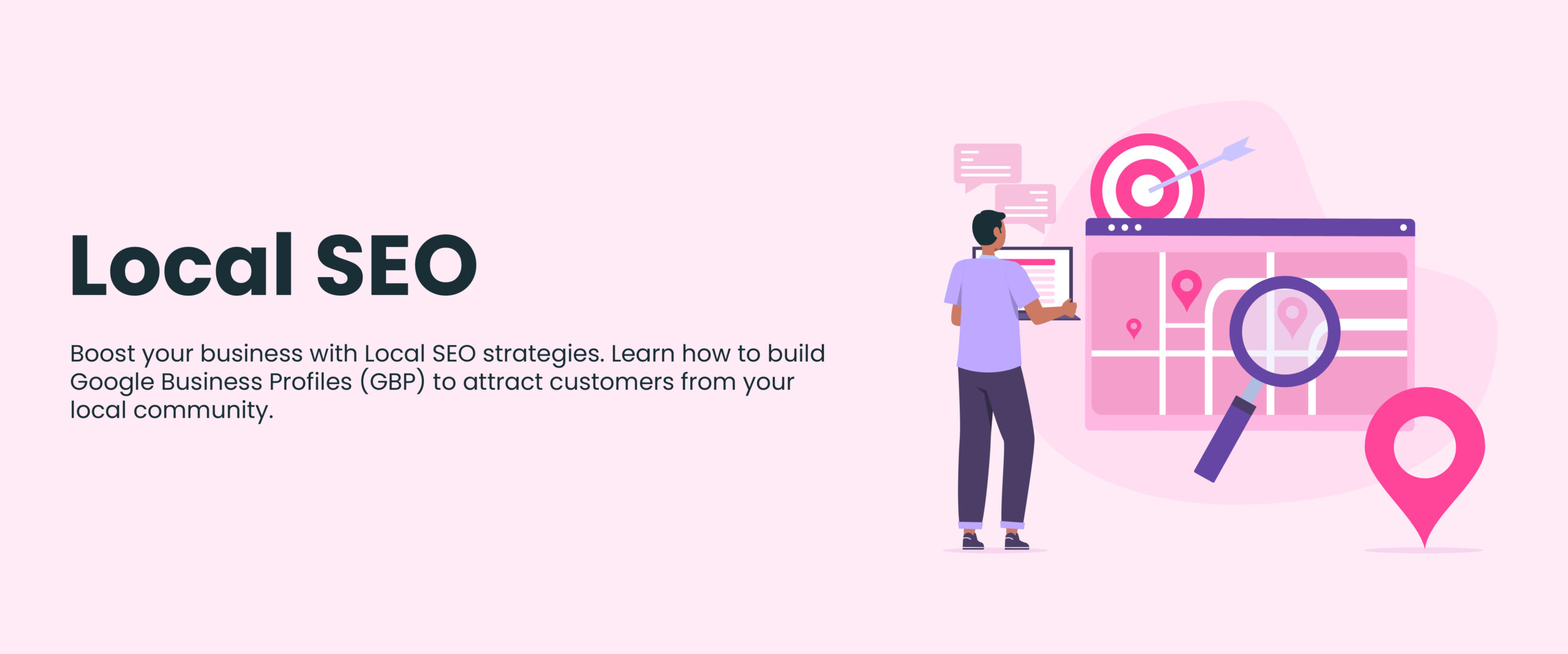Local SEO: Boosting Your Online Visibility in the Digital Neighborhood
Whether you run a small community store or a business with multiple locations, incorporating efficient local SEO tactics can have a substantial impact on your online presence, attracting customers within your vicinity. Did you know that just by optimizing your online store’s URLs, page titles, and headers with targeted keywords, you can significantly enhance visibility and attract a steady stream of targeted customers? In this blog, we will explore what local SEO means, and provide you with actionable insights to enhance your local search rankings.
Understanding Local SEO
Understanding Local SEO is essential for businesses looking to optimize their online presence and connect with local customers effectively. Let’s look at the importance and key elements of Local SEO, and take the following into consideration.
1. What is Local SEO?
Local SEO, or Local Search Engine Optimization, plays a crucial role in marketing strategies by enhancing the visibility of a website and attracting a larger number of local customers. This approach focuses on optimizing different online elements such as website content, meta tags, and directory listings, to improve rankings in location-specific search results.
This capability allows them to effectively focus on potential customers in the vicinity and attract more people to visit their brick-and-mortar stores or service locations. To get a better understanding of SEO do check out this digital marketing course.
2. Importance of Local SEO for Businesses
When speaking of Local SEO, some key points that need to be considered are:
- It plays a crucial role for businesses that rely on local customers.
- Focusing on local search optimization increases the chances of being discovered by people in the community actively searching for the products or services offered.
- This targeted approach drives relevant traffic to the website and improves the likelihood of conversions.
For example, consider “Joe’s Pizza,” a beloved local pizzeria. To enhance its online presence, Joe’s Pizza implemented effective local SEO strategies. As a result, they achieved higher rankings in local search results, capturing the attention of nearby customers in search of mouthwatering pizza.
Prioritizing local SEO empowers businesses to connect with their local audience, boosting visibility, expanding the customer base, and fostering sustainable growth.
3. Key Elements of Local SEO
The key elements are listed below:
i. Google My Business (GMB) Optimization
Optimizing your GMB listing is essential for local SEO success. Claim and verify your GMB profile, provide accurate business information, select relevant categories, and showcase high-quality images. Encourage customer reviews and promptly respond to feedback to build credibility.
ii. Localized Keyword Research
Conduct research to identify keywords with local intent. Consider including location-specific terms in your target keywords to align your content with local search queries. Utilize long-tail keywords that reflect the specific needs and preferences of your local audience.
iii. On-Page Optimization for Local Relevance
Optimize your website pages for local relevance. Include location-specific information on your website, optimize URLs, page titles, and headers with relevant keywords, and utilize structured data markup to provide search engines with detailed information about your business.
iv. NAP Consistency (Name, Address, Phone Number)
Consistency in your business’s NAP information across the web is crucial. Ensure that your name, address, and phone number are consistent on your website, GMB profile, and other directory listings. Inaccurate or inconsistent information can confuse search engines and potential customers.
v. Online Reviews and Reputation Management
Encourage your customers to leave reviews on platforms like Google, Yelp, or industry-specific directories. Monitor and respond to reviews to show your engagement with customers. Effectively managing your online reputation helps build trust and credibility.
Clear all the concepts of local SEO and get placed with our digital marketing course with placement guarantee.
Optimizing Your Google My Business (GMB) Profile
Optimizing your Google My Business (GMB) profile is essential for maximizing your online visibility and attracting potential customers. Take the following to optimize:
1. Claim and Verify Your GMB Listing
To establish complete control over your Google My Business (GMB) profile, it is crucial to claim ownership and complete the verification process. By doing so, you gain the ability to actively manage and update the information displayed, ensuring accuracy and timeliness for your business.
This ensures a reliable and authoritative online presence, establishing trust with potential customers.
2. Provide Accurate Business Information
To effectively provide business information, it’s important to ensure accuracy and currency. Take care to fill in all the required fields with precise details about your business. Include vital information like the business name, address, phone number, website URL, working hours, and any other relevant particulars.
3. Select Relevant Categories
When choosing categories for your business, it’s crucial to opt for the most relevant ones that accurately represent your products or services. Here are some key considerations to keep in mind:
- Be specific in your choices and ensure they closely align with what your business offers.
- Select categories that will help potential customers find you more easily.
- Increasing the chances of attracting the right audience is important.
For instance, if you run a home renovation company, relevant categories could include “Home Renovation Services.” If you operate an online store selling clothing, “Online Clothing Store” would be a suitable category. By thoughtfully selecting and specifying the appropriate categories, businesses can improve their visibility and increase their chances of success in reaching the right audience.
4. Showcase High-Quality Images
By uploading high-quality images, businesses can effectively capture the attention of potential customers. These visually appealing visuals provide a glimpse into the products or services offered, enticing viewers to explore further.
- A well-curated gallery of images showcases the business’s professionalism, attention to detail, and commitment to quality, making a strong impression on potential customers.
- For example, by displaying stunning, high-resolution images of your mouth-watering dishes, you’ll entice hungry customers to visit your restaurant.
5. Encourage Customer Reviews and Respond to Feedback
Encouraging customer reviews on your GMB profile is crucial for building trust and attracting new customers. Responding to positive or negative feedback promptly and professionally demonstrates your commitment to customer satisfaction and shows that their opinions are valued.
By actively engaging with reviews, you can enhance your reputation and establish a positive image for your business.
Localized Keyword Research and Implementation
Implementing localized keyword research and optimization strategies are essential for targeting your specific audience and improving your local search rankings, ultimately driving more relevant traffic to your business. Here’s how you can do it:
1. Identify Localized Keywords
When it comes to boosting your local search presence, it’s crucial to conduct thorough keyword research and pinpoint terms that are relevant to your specific location. Including location-specific words in your target keywords can significantly improve your visibility in local search results.
For example, localized keywords could include “best pizza in your city,” “plumber near me,” or “coffee shop in your neighborhood. By doing so, you’ll enhance your chances of attracting local customers and maximizing the impact of your online presence.
2. Utilize Long-Tail Keywords
Harnessing the power of long-tail keywords is essential for effective marketing. These specific phrases, tailored to a particular audience, are invaluable in attracting local customers. By integrating these keywords into your content strategy, you can optimize online visibility, attract targeted traffic, and ultimately drive conversions.
For example, long-tail keywords that resonate with your local customers, such as “affordable dog grooming services in downtown,” to target a specific audience effectively.
3. Incorporate Keywords in Title Tags, Meta Descriptions, and Headings
To improve your website’s search engine optimization (SEO), it’s important to include relevant localized keywords in your title tags, meta descriptions, and headings. This helps your site rank higher in search results for specific audiences. However, remember to write the content naturally and make it user-friendly, so that it resonates well with visitors and provides a positive browsing experience.
4. Optimize Content with Local Intent
When optimizing your content for local audiences, it’s crucial to create valuable and engaging material that specifically addresses their needs. Make it more relatable by incorporating location-specific information, such as mentioning nearby landmarks, events, or community initiatives.
For example, When writing a blog post about a restaurant, mention popular local attractions nearby, such as the city’s historic museum or famous park, to engage readers with a local focus. This will help your content resonate with the local community and increase its effectiveness in meeting their expectations.
5. Utilize Location-Specific Landing Pages
If your business operates in different locations, it’s beneficial to develop dedicated landing pages for each area. These pages should be optimized with location-specific keywords and unique content that speaks to the particular needs and interests of each community.
For example, if you have a chain of restaurants, create landing pages for each location with tailored content and local keywords. This approach not only improves your search engine visibility but also enhances the user experience, ultimately boosting engagement and conversion rates.


On-Page Optimization for Local Relevance
On-page optimization for local relevance is a crucial aspect of improving your website’s visibility and attracting location-based traffic. Here’s how you can do it:
1. Include Location-Specific Information on Your Website
To enhance your website’s visibility, it’s crucial to include location-specific information across various pages, such as the homepage, about page, and contact page. By strategically integrating details about your location, you improve user experience and help search engines recognize your local relevance. This increases the likelihood of attracting location-based traffic to your site.
2. Optimize URLs, Page Titles, and Headers
When it comes to boosting local visibility, optimizing your URLs, page titles, and headers with targeted keywords is paramount. This optimization technique effectively communicates to search engines the geographic relevance of your content, leading to improved visibility among local audiences.
For example, enhance your online store’s visibility by optimizing URLs, page titles, and headers with relevant keywords, attracting targeted customers.
Conclusion
Local SEO presents a tremendous opportunity for businesses to increase their online visibility, attract local customers, and grow their revenue. By optimizing your Google My Business profile, conducting localized keyword research, implementing on-page optimization strategies, ensuring NAP consistency, and leveraging online reviews, you can enhance your local search rankings and establish a strong digital presence in your neighborhood.







